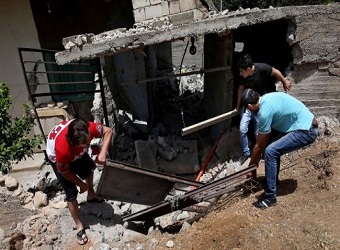The international body tasked with ensuring Syria’s chemical weapons are eliminated has enough money to fund its mission only until the end of this month, and needs more funds soon for the destruction of poison gas stocks next year.
An official at the Organisation for the Prohibition of Chemical Weapons, which won the Nobel Peace Prize last month, expressed confidence that governments would find more money to ensure the process does not lose momentum.
The OPCW has so far raised about 10 million euros ($13.5 million) to inspect Syrian chemical weapons sites under a U.S.-Russian agreement reached in September. But it will need much more to destroy more than 1,000 tonnes of chemical weapons declared by Syria.
An OPCW document seen by Reuters said the organization’s leadership believed it could cover staff costs of the Syrian mission until the end of this month.
“It is the assessment of the Secretariat that its existing personnel resources are sufficient for operations to be conducted in October and November 2013,” said the document which was dated October 25, adding that an OPCW trust fund for its Syrian work held just 4 million euros at the time.
Syrian forces have already rendered inoperable declared chemical production facilities under OPCW supervision. The next stage, the removal and destruction of the chemicals themselves, possibly abroad, will be far more expensive.
Syrian President Bashar al-Assad has said the total cost of the operation could be $1 billion. Experts believe it is likely to be less but will still run into tens or hundreds of millions of dollars, depending on where and how the chemical arms are destroyed.
“The destruction will require significant funding,” said Malik Ellahi, political adviser to the OPCW’s director general. However, he added: “The states parties are resolved to the task. They haven’t come this far to completely lose the momentum and let the whole thing slip.”
Syria itself could not fund the next stage. “The Syrians are broke and they can’t afford it and everyone knows. That was part of the deal,” Ellahi told Reuters. “States parties are seriously working on a number of solutions and we don’t expect there is going to be any (financial) crisis.”
The United States has been the biggest contributor to the OPCW’s fund for the Syria mission, with Britain, Canada, Germany, the Netherlands and Switzerland also contributing.
Washington has contributed $6 million in equipment, training and cash, split between funds with the OPCW and the United Nations, the OPCW document said.
Under the joint Russian-American proposal, Syria agreed in September to destroy its entire chemical weapons program by mid-2014. The move averted missile strikes threatened by Washington following an August 21 sarin gas attack in the outskirts of Damascus that killed hundreds of people.
RISING COSTS
Until September, Syria was one of a handful of countries that were not party to a global treaty outlawing the stockpiling of chemical arms.
Damascus’s joining of the Chemical Weapons Convention creates the unique problem of safely destroying huge stockpiles of poisons in the middle of a civil war that has killed 100,000 people and driven up to a third of Syrians from their homes.
Personnel costs will be largely covered by the OPCW’s regular budget, less than an annual $100 million, but the Hague-based organisation will need substantial additional resources.
A Syrian delegation arrived in The Hague on Tuesday to begin discussions aimed at finalizing plans for destruction of the chemical weapons, the OPCW said in a statement.
The OPCW and Syria must agree to a detailed plan by mid-November, explaining in detail how and where to destroy the poisons, including mustard gas, sarin and possibly VX.
The OPCW said last week its teams had inspected 21 out of 23 chemical weapons sites across the country, meeting a November 1 deadline. Two other sites were too dangerous to reach for inspection, but critical equipment had already been moved to other sites that experts had visited, it said.
Syria declared to the OPCW 30 production, filling and storage facilities, eight mobile filling units and three chemical weapons-related facilities.
They contained about 1,000 tonnes of chemical weapons, mostly in the form of raw precursors, 290 tonnes of loaded munitions and 1,230 unfilled munitions, OPCW documents showed.
The OPCW said in a statement that as of Tuesday, Syria has reported the destruction of 99 unfilled munitions or warheads at one site with another 55 due to be destroyed at a second site. Similar work has begun at five other sites, it said.
Four other countries have promised an additional 2.7 million euros to the OPCW fund, the document said. Germany, Italy and the Netherlands supplied air transport to fly OPCW team members to Syria, while other European countries and the United States provided armored vehicles that were shipped by Canada, it added.
SHIP TO ALBANIA?
Britain has pledged $3 million, while Russia, France and China said they will donate experts and technical staff, who need to witness the lengthy destruction process.
Discussions are underway with countries willing to host facilities for incinerating or chemically neutralizing the poisons, including Albania, Belgium and an unspecified Scandinavian country, two sources familiar with the discussions said.
Companies in the United States, Germany and France are competing for the contract to provide destruction facilities, the sources said.
Since being established under the 1997 Chemical Weapons Convention, the OPCW has overseen the destruction of more than 50,000 tonnes of toxic munitions, or more than 80 percent of the world’s declared stockpile. The United States and Russia, the largest possessors of chemical weapons, are years behind schedule in destroying their arsenals.
Source: Reuters
